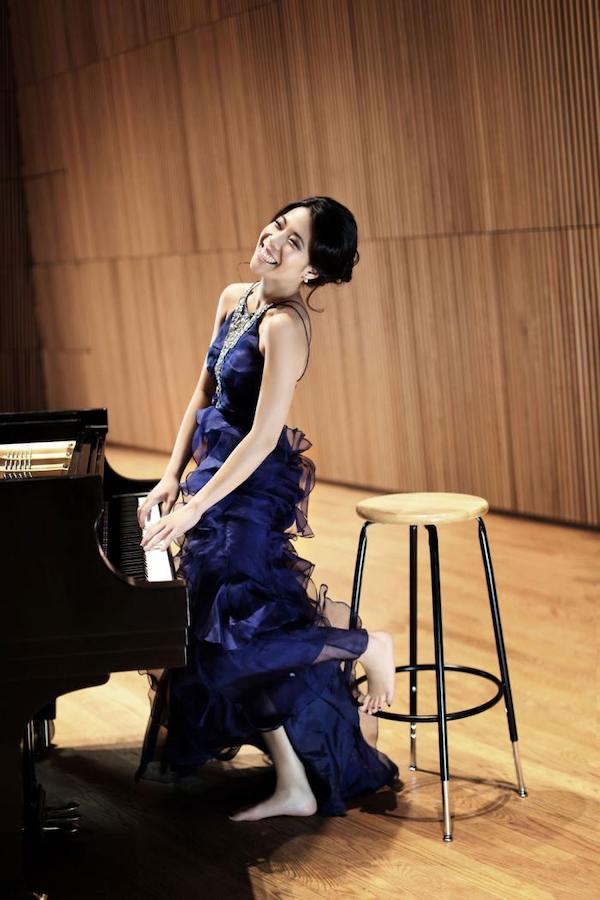Yang’s Liszt thrills and Fischer’s Ravel sways with Utah Symphony

With a program including John Adams, Liszt, and a quirky collection of Ravel pieces, Thierry Fischer’s second concert with the symphony after his five-month absence displayed the eclectic programing that has marked his 12 years as music director.
The evening led off with Adams’ Slonimsky’s Earbox. Written in 1995, this tribute to the Russian-born musician and scholar Nicolas Slominsky is a shining example of the post-minimalist style Adams developed in the mid-1980s.
The work which features cells of rhythmic ostinato passages, set in motion and juxtaposed against one another like gears in a clock, with a free-form melody in the brass or strings skipping exuberantly above them. The piece also features moments of shimmering stillness, with sustained notes in ambiguous harmonies.
Wielding a full orchestra plus piano, bells, synthesizer, and Adams’ trademark woodblock, Slonimsky’s Earbox achieved glorious sonorities and rhythmic effects. Fischer conducted with clarity and precision, highlighting the piece’s layers and counterpoint.
Pianist Joyce Yang was the solo protagonist in a delightful and technically flawless rendition of Liszt’s Piano Concerto No. 1 in E flat Major.
The piece begins with a severe, forceful tutti in C minor followed by a forceful display of pianistic fireworks that dissipates into a softer, subtler repeat of the opening theme in the orchestra. This, in turn heralds the piano’s second entrance, which is a soft lyrical passage, reminiscent of a Chopin nocturne. These two entrances allow soloists to display both technical prowess and lilting musicality in the piece’s first two minutes, and Yang took full advantage, quickly establishing her unique take on the piece.
Marked by breathtaking displays of technical brilliance and moments of spellbinding intimacy, Yang’s solo fireworks were deftly reflected and accentuated by Fischer and the orchestra, capturing the piece’s emotional contrasts.
Yang played the bombastic runs with precision and panache, setting them up as a contrast to the fleeting contemplative moments, to which she gave a soulful depth. The highlight of the first movement was a mournful melody that grew into a duet with the clarinet and then the violin. Together with clarinetist Tad Calcara and concertmaster Madeline Adkins, Yang created a moment of breathtaking beauty.
The most striking examples of Yang’s soulfulness came in the second movement. Not a note was too loud or too soft in her solo playing, and the starkly exposed melody had an imaginative and playful flair. This playfulness carried into the spry scherzo section, in which Yang displayed a light touch and varied tone, and the technically formidable third movement, in which she made the trills and runs sound effortless and fun.
Yang’s technique in the third movement was dazzling—perfect trills and octave runs—but it aptly remained subservient to the leading melodic lines. The climactic ending was as joyful as it was forceful and brought the audience to its feet. For her encore Yang performed Rachmaninoff’s Prelude in G sharp Minor, making the left-hand melody sing beautifully under a right-hand accompaniment.
The concert’s second half was dedicated to Ravel, specifically his Une barque sur l’ocean (A boat on the ocean) La Valse, and Valses nobles et sentimentales. Fischer achieved a beautiful sound and employed clear phrasing in Une barque and Valses nobles, though both could have used a stronger rhythmic pulse at times. Une Barque simulated the ocean with great orchestral swells, but Fischer’s straightforward beat made for a sea that was too placid to be engaging.
La Valse, by contrast, had an infectious rhythm, which seemed to make the whole hall sway. The piece begins with a rumble in the basses and quickly grows into the full, rich orchestral sound characteristic of Ravel. Fischer imbued the opening crescendo with playful suspense and gave the whole piece a charming sentimentality. The lovely, vibrato-filled sound Fischer achieved in the strings contrasted with the smoother sounds employed in the Liszt and the Adams. The dynamic contrasts were also thrilling, with the smaller swells leading to a satisfying and powerful climax at the end.
The program will be repeated 7:30 p.m. Saturday at Abravanel Hall. www.usuo.org